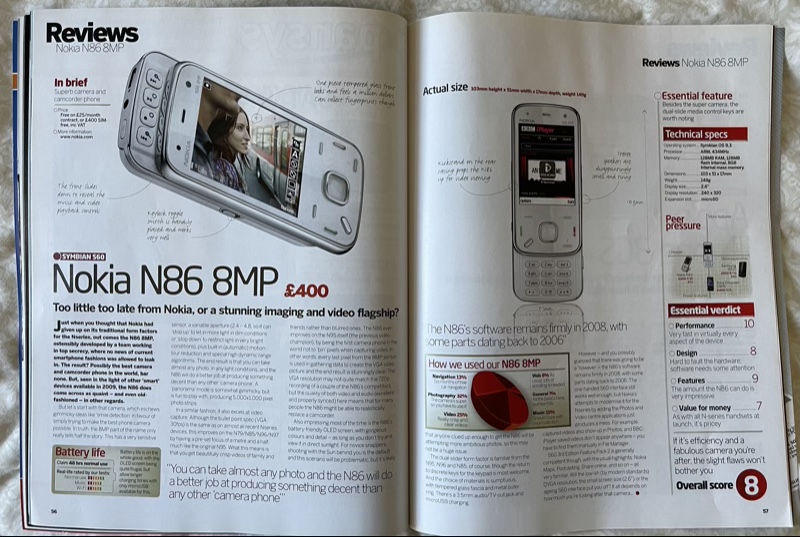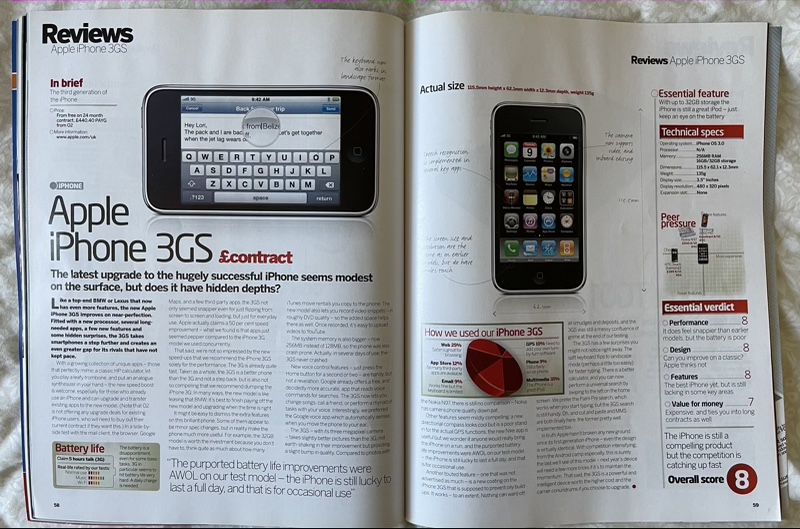Here's the issue's front page - I'll refrain from photographing individual articles, but will just put in thumbnails and then quote the relevant sections in plain text, I think this will be more helpful!

I do remember recycling almost all my old PDA Essentials and Smartphone Essentials issues (they send each over for free to everyone who had written something in it), but I kept this one because of the time period, covering the pivotal few months where Nokia arguably lost the plot and Apple got started in earnest on its stratospheric rise.
Again, steering clear of my own writing (so as to eliminate confirmation bias, plus I tended to do help desk and analysis/feature articles), let's pick out items of notable choice, remembering the date - mid-2009. It's an interesting snapshot of a fast changing tech world!
1. Samsung goes Android
In the News section was "the Samsung i7500, also known as the Galaxy", Samsung's first Android handset, to complement its Symbian and Windows Mobile smartphones. The magazine said "A solid start to Samsung's Android adventure". Bit of an understatement, in hindsight. Within a couple of years, Android was all Samsung built on, and within five years it was dominating the world sales charts, at least in terms of unit sales.
2. Palm Pre coming
"Palm Pre coming to the UK on O2" was the headline, with comment "The Pre's launch in Europe will be a very important step for the beleagured Palm". Despite a futuristic swipe UI (next seen in devices like the Meego-powered Nokia N9), the Pre failed to take off. Partly its tiny size in an era when phone screens were growing in size, partly because there was minimal marketing or reviewer outreach - quite simply, only geeks ever even saw this device.
3. App Store Wars

A look at the four main 'app stores' on smartphones, the Nokia Ovi Store is damned with faint praise: "puts all available content - including media and wallpapers - into one interface". Blackberry App World's selection "wasn't great", but "showed promise". Most interesting was the somewhat scathing "The Android Market focusses on 'single use' apps rather than commercial games and apps from major software companies". Google's Android store did in fact grow to rival the depth of Apple's iOS App Store, which was described as "the king of the app stores by far", with a whopping "50,000" apps(!) In practice, the fortune of the app stores merely followed the success of their host platforms, I'd argue. Even Nokia's Ovi Store wasn't terrible - it was just slow (being written in HTML!) and died with Symbian itself four years later.
4. 'Widescreen phones'

A pretty terrible 'category' by today's standards, but back in 2009 a 3.5" or 4" screen was enormous. So the editorial team took it as a theme for a review of the:
- Nokia N97 - "a little chunky to hold", but "its build quality is generally top notch". "The 3.5" accelerometer-driven screen was large and generally acceptable for most tasks, with icons looking crisp and clear". Finally, "Performance was OK, with its 434MHz CPU coping with most tasks. Its resistive touchscreen sometimes requires an additional press to register properly and its Wifi was a little fiddly to set up." There was battery concerns, which I don't remember from my time with the N97 in 2009. Overall, the score was 7/10, with the reviewer saying that the N97 "wasn't quite as exciting to use as we would have hoped for".
- Samsung i8910 HD - also a Symbian/S60 5th Edition smartphone, remember, but with a Samsung custom homescreen. I had this phone as well for quite a while and it was a beast for its time in terms of hardware. The magazine review said "its AMOLED was lush, clear and vivid" - in a world where LCD was standard, this was year one of AMOLED making its way into the world. "Massive spec with 3.5G that supports 5.6Mbps upload speeds. Add in HW 3D acceleration, a fast 600MHz CPU, 8GB storage, a fantastic 8MP camera and a GPS, and you've got plenty to keep you going." Well said, and these numbers were high for 2009. Importantly, the touchscreen was also capacitive, like the iPhone's, resulting in the magazine saying "the screen was a lot more responsive than the Nokia's". From memory, the downside of the device was that quite a bit of S60 software either wasn't available or didn't work fully - and there was no Nokia Ovi Store for apps. Overall score was 9/10.
- Acer F900 - Acer's front end for Windows Mobile (6) pushes the envelope in terms of using up the meagre 128MB RAM, with the magazine saying "Memory is the biggest problem, so a bit of TLC is required to keep the phone running smoothly". Possibly because of the RAM issue, they were "getting noticeable lag when running only four basic programs". On the plus side, this had a SiRFstarIII GPS which "was a highlight",and battery life was "pretty respectable". The design was ultimately flawed by "a side mounted miniUSB port that is not ideally placed considering you need to use it for headphones, and the touch sensitive buttons at the base of the screen are difficult to distinguish from the casing unless they're pressed." Ah yes, old school light up controls that you can't see until after you've used them! The review score was a paltry 6/10.
- HTC Touch Diamond 2 - like Acer, HTC loved to add a skin ('TouchFLO 3D') over Windows Mobile 6, bringing larger finger-friendly touch targets to mimic the UI elements in the iPhone. Although "its 3.2" screen is rather small", it was praised as having "superb build quality" and "unlike the Acer, its front-facing Windows buttons are physical, being slightly raised". Interestingly, this was an era before oleophobic screens, and the reviewer noted "an excessive build up of grease... leaving you constantly wiping the device over your sleeve to clean it up". (2009 was the year that Apple's iPhone 3GS first introduced an oleophobic coating, see below, something we take for granted nowadays.) The HTC Touch Diamond 2 "generally performed really well in most areas", but at the expense of battery life which "is not its best feature". Overall, it scored 8/10.
Fascinating to see a Symbian-powered handset winning out, even in 2009, though not under the Nokia banner. 2010 would see Android coming along in larger numbers, to take over the fight for 'widescreen phones'! HTC was one such that adopted Android, while the N97's sales were disappointing and it was quickly 'replaced' by the slicker N97 mini, while Samsung failed to commit further to Symbian and also went 'Android', as mentioned above.
5. Nokia N86 8MP

In the main review section now, the N86 was one of my most loved smartphones from the last 15 years - but I wasn't the one reviewing it for the magazine! The headline feature was the new, large, dual aperture camera, and "you can take almost any photo and the N86 will do a better job at producing something decent than any other 'camera phone'..." Video capture in particular was "stunningly clear", thanks to using all the pixels on the sensor to composite the final VGA video, helped also by the hyperfocal nature of the lens system in video mode. Having mentioned AMOLED above, "also impressing most of the time is the N86's battery-friendly OLED screen, with gorgeous colours and detail".
The N95-like form factor is "familiar" but the "return to discrete keys for the keypad is most welcome. And the choice of materials is sumptuous, with tempered glass fascia and metal outer ring." The use of S60 3rd Edition puts "the N86's software firmly back in 2008, with some parts dating back to 2006". Which is fair enough, this was the last great non-touch Symbian device, I contend. The overall verdict was "if it's efficiency and a fabulous camera you're after, the slight flaws won't bother you", with a score of 8/10.
I can't imagine the N86 sold that well in the climate of all-touch 2009, but the units it did sell went to very appreciative owners - myself being one such!
6. Apple iPhone 3GS

Arguably the point at which Apple's iPhone hardware could be taken seriously, this scores 8/10 here - it's curious that this wasn't higher, but the power-hungry internals of the iPhone were still seen as 'abnormal', with the review saying "the purported battery life improvements were AWOL on our test model - the iPhone is still lucky to last a full day, even for occasional use". While that clearly isn't acceptable, Apple put in larger cells into its later models to compensate for the needs of the chipsets.
On the positive side, rather tellingly, the review opens with "Fitted with a new processor, several long-needed apps, a few new features, and some hidden surprises, the 3GS takes smartphones a step further and creates an even greater gap for its rivals that have not kept pace." Imaging was better on the 3GS, but the review noted "compared to photos with the Nokia N97 there is still no comparison - Nokia has camera phone quality down pat". And indeed I'd argue that it took Apple until about 2017 to really catch up to the Nokia/Microsoft of the same time frame...
Back to the 3GS, "the soft keyboard flips to landscape mode for faster typing" - I'm not sure this was scalable though - larger phones of today are a right pain typing in landscape mode, while the 3.5"-screened 3GS wasn't much wider in landscape than larger phones today are in portrait!
____________
There are other reviews and features, but you get the idea - I've delivered the most relevant highlights. My overall impresison from going back 12 years is of a smartphone world on the point of major transitions:
- Symbian was struggling, partly thanks to the mess that was S60 5th Edition (part touch, part fake-button-press!), and even the rewrite that was Symbian^3 couldn't do more than slow the OS's eventual demise. The rewrite should have come along a couple of years earlier. Easy to say this in hindsight, of course!
- The stylus-centric Windows Mobile 6.x was dead in the water and only 'skins' over the top made the devices mentioned above possible. Microsoft rewrote its mobile OS as Windows Phone 7.5, but it took another year to appear and wasn't feature complete until 2011, which have iOS and Android a big headstart.
- Apple and iOS were on an obvious ascendant course, thanks to a futuristic tech vision and backed by mind-numbingly large resources for development. And price be damned - iPhones still sell to the wealthiest countries and demographics, but hey, that's where the profit is!
- Android adoption was still very new, but the years from 2010 through to today saw it dominate the market in terms of phone market share worldwide.
- Non-touch devices were increasingly being seen as for 'normobs' and 'retro' - the enthusiast market was becoming all about touch, and capacitive touch at that.
Comments welcome. Were you a smartphone user in 2009? How accurate do you think Smartphone Essentials magazine's reviews were, either at the time, or in hindsight?
PS. As for the magazine itself, it made it through a couple of years more, but just as with the rest of the magazine industry, struggled to compete with free online news and feature sources (not least the 'All About' sites, eh?!)
